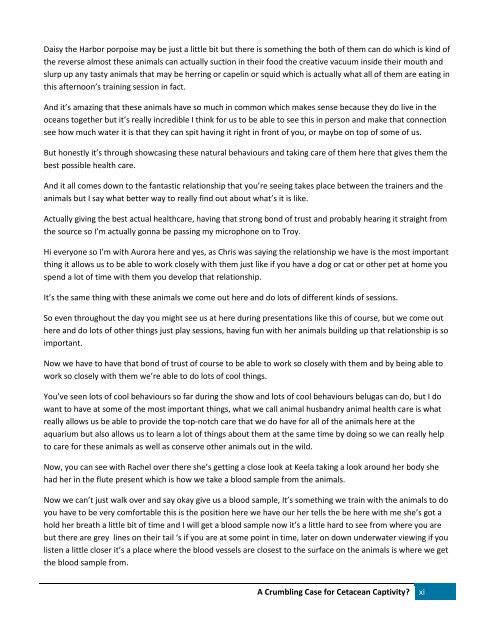A CRUMBLING CASE FOR CETACEAN CAPTIVITY?
MM-Education-and-Conservation-Report-Dec-9-2016-fi
MM-Education-and-Conservation-Report-Dec-9-2016-fi
Create successful ePaper yourself
Turn your PDF publications into a flip-book with our unique Google optimized e-Paper software.
Daisy the Harbor porpoise may be just a little bit but there is something the both of them can do which is kind of<br />
the reverse almost these animals can actually suction in their food the creative vacuum inside their mouth and<br />
slurp up any tasty animals that may be herring or capelin or squid which is actually what all of them are eating in<br />
this afternoon’s training session in fact.<br />
And it’s amazing that these animals have so much in common which makes sense because they do live in the<br />
oceans together but it’s really incredible I think for us to be able to see this in person and make that connection<br />
see how much water it is that they can spit having it right in front of you, or maybe on top of some of us.<br />
But honestly it’s through showcasing these natural behaviours and taking care of them here that gives them the<br />
best possible health care.<br />
And it all comes down to the fantastic relationship that you’re seeing takes place between the trainers and the<br />
animals but I say what better way to really find out about what’s it is like.<br />
Actually giving the best actual healthcare, having that strong bond of trust and probably hearing it straight from<br />
the source so I’m actually gonna be passing my microphone on to Troy.<br />
Hi everyone so I’m with Aurora here and yes, as Chris was saying the relationship we have is the most important<br />
thing it allows us to be able to work closely with them just like if you have a dog or cat or other pet at home you<br />
spend a lot of time with them you develop that relationship.<br />
It’s the same thing with these animals we come out here and do lots of different kinds of sessions.<br />
So even throughout the day you might see us at here during presentations like this of course, but we come out<br />
here and do lots of other things just play sessions, having fun with her animals building up that relationship is so<br />
important.<br />
Now we have to have that bond of trust of course to be able to work so closely with them and by being able to<br />
work so closely with them we’re able to do lots of cool things.<br />
You’ve seen lots of cool behaviours so far during the show and lots of cool behaviours belugas can do, but I do<br />
want to have at some of the most important things, what we call animal husbandry animal health care is what<br />
really allows us be able to provide the top-notch care that we do have for all of the animals here at the<br />
aquarium but also allows us to learn a lot of things about them at the same time by doing so we can really help<br />
to care for these animals as well as conserve other animals out in the wild.<br />
Now, you can see with Rachel over there she’s getting a close look at Keela taking a look around her body she<br />
had her in the flute present which is how we take a blood sample from the animals.<br />
Now we can’t just walk over and say okay give us a blood sample, It’s something we train with the animals to do<br />
you have to be very comfortable this is the position here we have our her tells the be here with me she’s got a<br />
hold her breath a little bit of time and I will get a blood sample now it’s a little hard to see from where you are<br />
but there are grey lines on their tail ‘s if you are at some point in time, later on down underwater viewing if you<br />
listen a little closer it’s a place where the blood vessels are closest to the surface on the animals is where we get<br />
the blood sample from.<br />
A Crumbling Case for Cetacean Captivity?<br />
xi


